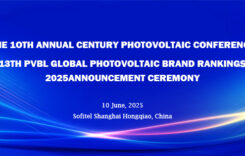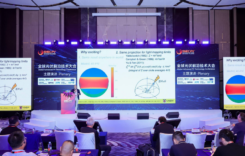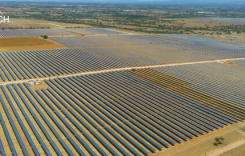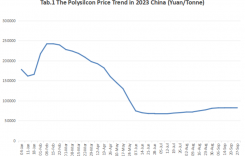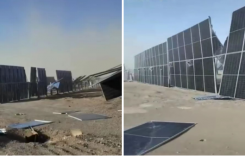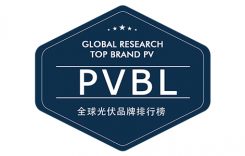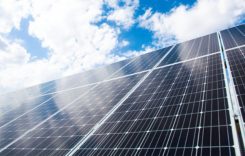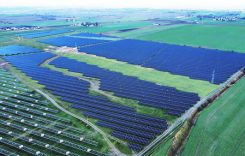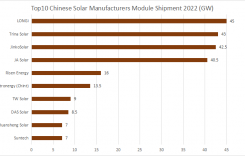PVTIME – “As advancements in photovoltaic technology continue and costs steadily decline, the solar industry is increasingly overcoming the challenges posed by the intermittency and discontinuity of solar power in certain regions. This positions the sector to play a pivotal role in accelerating the global shift toward energy equity.” The potential of this transformation was underscored at the 29th Conference of the Parties (COP29) to the United Nations Framework Convention on Climate Change, which kicked off in Baku, Azerbaijan.
On November 15, Zhang Haimeng, Vice President and Chief Sustainability Officer of LONGi Green Energy Technology Co,Ltd (hereafter as “LONGi”), spoke as one of the Chinese business representatives at a side event titled “Belt and Road Climate Change South-South Cooperation and Green Open Cooperation Practices and Cases” at the China Pavilion, sharing insights into China’s innovative strategies and successful initiatives in combating climate change and promoting South-South cooperation.
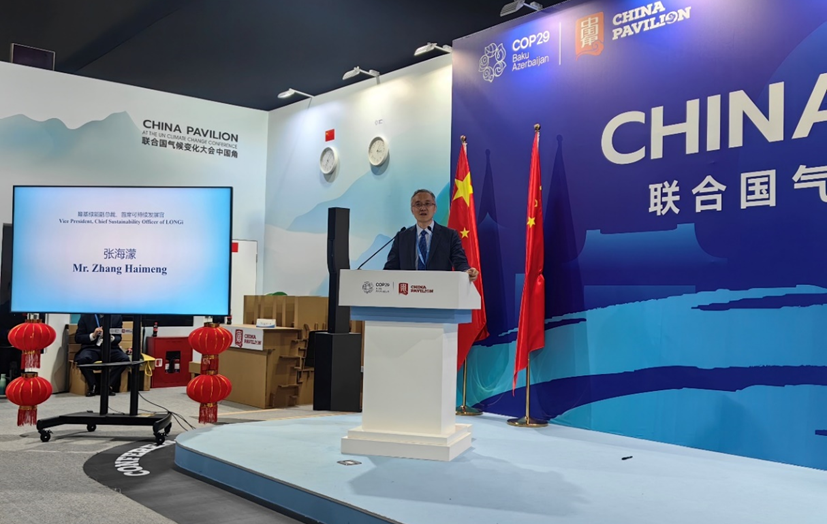
“Green Power + Green Hydrogen”: A Dual-Tech Approach Driving the Global Energy Transition
LONGi is actively aligning with China’s Belt and Road Initiative, focusing on South-South cooperation with developing countries to tackle climate change challenges. As part of this effort, the company has successfully completed its first large-scale photovoltaic project in Azerbaijan’s Gobustan region.
The project, which uses LONGi’s high-efficiency monocrystalline solar module products, has become the largest solar power plant in this area, with an individual capacity of 230MWac and spanning approximately 5.5 million square meters.
Since it was successfully grid-connected on October 26, 2023, the annual power generation of the station has reached 500 million kWh, enough to supply electricity to 110,000 households in the region. It also reduces CO2 emissions by over 200,000 tons annually, contributing to a fundamental shift in Azerbaijan’s energy landscape.
The project not only showcases LONGi’s cutting-edge technology in the photovoltaic sector but also highlights the growing influence of Chinese companies in driving green development across Belt and Road countries.
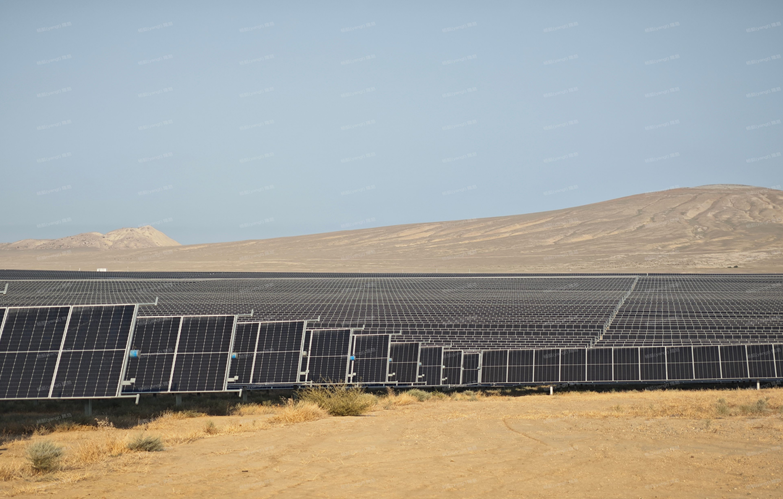
Zhang Haimeng highlighted that the world has now entered the era of 2 TW in cumulative renewable energy capacity, with LONGi contributing 27% of that total. Following the principle of win-win joint ventures, LONGi has not only exported cutting-edge technology and operational expertise but also harnessed the power of solar energy to improve the environmental and energy supply infrastructure in Belt and Road countries. In many remote regions, solar power has become the primary source of electricity.
Nowadays, LONGi is at the forefront of the push for a cleaner, more efficient, and sustainable energy future, leveraging its “Green Power + Green Hydrogen” dual-tech strategy. This approach is pivotal in advancing global energy transition and achieving carbon neutrality. Zhang Haimeng emphasized, “LONGi Hydrogen has made significant progress in advancing green hydrogen, delivering over 350 MW of projects globally and securing contracts for more than 500 MW. We are leading the fight against climate change, driving the energy revolution, and producing economically viable ‘Green Energy Pillars’ to help industries achieve deep decarbonization.
With significant achievements across sectors like petroleum refining, ammonia synthesis, metallurgy, and transportation, the company has particularly excelled in China’s first 10,000-ton green hydrogen refining project and the world’s largest green hydrogen-to-ammonia project. In both, its hydrogen electrolyzers have demonstrated exceptional safety, reliability, and stability. During a side event, Zhang Haimeng emphasized LONGi’s commitment to deepening partnerships with developing countries like Azerbaijan to confront climate change and promote global energy equity and sustainable development.
The Urgent Need for International Standards and Certification Systems for “Green Energy Pillars”
While solar power has become the most cost-effective source of electricity, many energy-intensive industries remain hard to electrify and rely on green hydrogen, green alcohol, green ammonia, and other “Green Energy Pillars” to cut emissions. However, there is still no clear global definition or standard for these “Green Energy Pillars”. Take green hydrogen in the steel industry as the reference: the production cost of gray hydrogen is far lower than that of green hydrogen. Without established product standards or certifications, steelmakers aiming to meet emissions reduction targets struggle to demonstrate to the market that they are using green hydrogen. As a result, the promised green premiums and carbon tax penalties fail to create a complete economic cycle, making it hard for low-carbon products to compete with their high-carbon counterparts. Without clearer financial incentives, most companies are reluctant to invest in green hydrogen voluntarily.
The adoption of green ammonia faces similar dilemma. In efforts to reduce emissions by blending green ammonia with coal power, the absence of internationally recognized certification standards prevents coal power companies from effectively offsetting the cost difference between gray and green ammonia, resulting in little motivation to pursue such initiatives. As a result, the establishment of global standards and certification systems for “Green Energy Pillars” is becoming increasingly urgent. Zhang Haimeng pointed out that most regional standards for defining green electricity are still based on a country’s average power emissions factor, which undermines efforts by companies to actively adopt green electricity. Even when individual companies increase their use of green electricity in specific projects, they remain tethered to their country’s overall emissions average. Without more precise identification and certification, and without proper incentives for green electricity users, relying on carbon pricing to drive the energy transition will be nearly impossible.
Zhang Haimeng offers a pointed insight into the financial hurdles of the green transition: “Relying solely on transfers from developed countries to developing ones makes this goal difficult to achieve. We need to unlock existing market capital, like bank loans and green bonds, through more commercially viable models.” LONGi’s experience underscores a key challenge: many green hydrogen projects in resource-rich, developing regions face inflated financing costs due to “country risk” concerns. As Zhang Haimeng explained, “In Europe, green hydrogen financing typically costs less than 8%, but in Africa—despite low renewable energy costs—rates can exceed 15%, complicating funding efforts.”
From the view of Zhang Haimeng, it is crucial to mobilize relevant financial resources and design targeted financial instruments, such as green insurance or green guarantees, to mitigate the country risk assessment for potential investors. This strategy would unlock significant market capital, sidestep the political complexities of inter-country transfers, and set decarbonization efforts on a positive trajectory.
BC Technology Fuels South-South Cooperation, Advancing Energy Equity and Ecological Protection
“We are at a critical period in the global energy transition,” Zhang Haimeng said. “Factors like resource availability, economic development, energy technology, and geopolitical differences are deepening energy imbalances across regions. Energy remains a key bottleneck to economic growth in many areas.” He stressed that only by securing basic energy supplies can living standards in impoverished regions improve, fostering local economic development. At the same time, the unequal distribution and limited affordability of fossil fuels hinder global energy equity.
At COP29, LONGi’s advancements in Back-Contact (BC) technology attracted significant attention. “Many countries, driven by energy security and economic development needs, are eager to localize the photovoltaic industry,” said Zhang Haimeng. “LONGi recognizes and respects this, which is why we partner with local players, often relinquishing majority control to foster shared benefits and responsibilities. Our focus is on driving regional energy transitions and nurturing local solar industries.” He added that LONGi is rapidly scaling BC production capacity through licensing and equity partnerships to meet the surging demand for BC products.
At the critical period of global energy transition, LONGi is playing a key role in advancing energy equity and sustainability. Through innovations like BC technology, the company has not only accelerated its industrialization but also established full laser technology as the mainstream approach for BC.
This year, LONGi’s HPBC 2.0 technology platform achieved a production efficiency of over 26.6%, setting a new global benchmark for mass-produced cell efficiency. Its widespread application promises to significantly boost the efficiency and reliability of solar power, driving progress toward energy equity and sustainability. Additionally, LONGi is partnering with organizations like the UNHCR to deploy BC technology, providing electricity to vulnerable populations, including refugees, and improving their living standards.
At the same time, LONGi is deepening South-South cooperation with developing countries through photovoltaic technology, advancing both climate action and energy equity. In South Africa, the company donated solar panels to the Aquila Wildlife Conservation Reserve, providing reliable power, nighttime lighting, and clean water for wildlife. This initiative has significantly improved the reserve’s ecological environment and enhanced animal welfare, underscoring LONGi’s commitment to biodiversity conservation.
At COP29, LONGi also partnered with the IUCN to launch a biodiversity initiative, leveraging the IUCN’s global expertise to strengthen its conservation efforts. “This collaboration will help raise awareness among global partners, policymakers, and the public on the importance of biodiversity protection and enable us to tackle global ecological challenges together,” said Zhang Haimeng.


